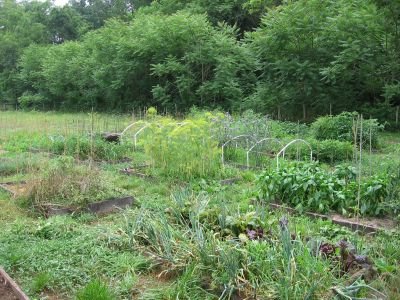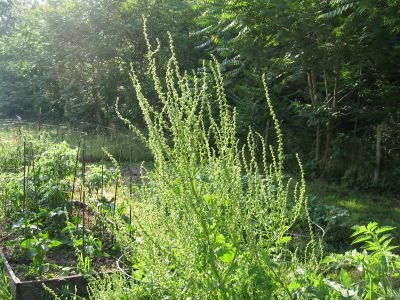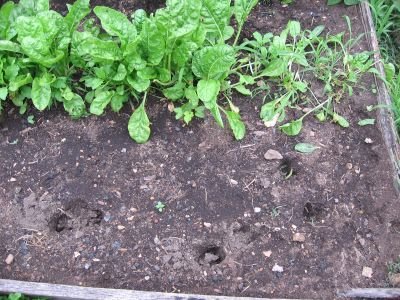 My Garden Today: Not A Single Snap Pea In Sight
My Garden Today: Not A Single Snap Pea In SightExperimenting in the garden can be exciting and rewarding. The boring gardener is one who contentedly cultivates the same reassuring standbys year after year, reluctant to take a chance, intimidated by the unknown. Pass the zucchini and cherry tomatoes please--no purple bush beans or Spanish black radishes for these cautious souls! The adventurous gardener, on the other hand, is a daring thrill-seeker, willing to try growing anything at least once. To him or her, a packet of unfamiliar seeds is the first step of a bargain-priced journey into unexplored territory. Of course if you have no idea what you are growing, you might find yourself in a bit of an entanglement.
When I moved to
Windridge Farm in 1995 and my kitchen garden suddenly grew from one 7-foot x 25-foot plot to twenty 7-foot x 25-foot plots, the possibilities seemed endless. I went crazy and ordered dozens of types of seeds: vegetables I had always dreamed of growing, herbs I had read about in books, exotic produce from the pages of glossy gourmet cooking magazines. It was a fascinating and educational season as I harvested
kohlrabi,
escarole,
arugula, celeriac, and many other tasty things for the first time. For the most part I did not encounter any major difficulties, even from the plants with which I was completely unfamilar. No, the only complications sprouted from an unassuming little packet simply labeled
Sugar Snap Peas.
The only thing I knew about peas was that they could be planted early, so I carefully placed the shriveled little bits in the ground before anything else. As I waited for them to emerge, I tried to imagine the first ambrosial bite from the garden. That got me wondering just exactly what I was growing. I decided to ask around.
"So, do you know what sugar snap peas are?" I would casually insert into conversations. Such a simple question, such pathetic answers. The responses ranged from, "Sure, the company I work for sells frozen packages of those. They're uh. . .uh. . ." to a very emphatic, "I hate peas." I was clearly on my own.
The spring days were sunny and warm, and my pea seedlings quickly began shooting up. Straight up, and up, and up. Then they started to fall over. Something was obviously missing, and I realized it was a support system. Never a big fan of trellising and all that complicated stuff (my one short skirmish with pole beans had been a dismal failure), I realized that I had inadvertantly planted something that would require me to erect some sort of vertical structure. Oh joy.
Unenthusiastic but determined to assist my first crop of the year, I looked around the farm for a creative and cheap solution and found it in fencing supplies and a ball of string. I decided I would place 6-foot metal fenceposts at each corner of the plot and then run 48-inch high woven-wire fencing along the two longest sides. The peas were planted in short rows perpendicular to the fencing, so I would tie pieces of string to the top of each fence, suspending them over the rows. Then to the main string I would tie shorter pieces which would hang down to each plant. All I would have to do is wrap the plants' tendrils around the string, and simply let string and vine hold each other in place. It was a brilliant idea, and I executed it magnificently, a true testament to simplicity and resourcefulness. Even my husband (who had offered to build me a "real" trellis) was impressed. The peas grew like mad and were soon covered with beautiful white blossoms.
Everything looked great--for about a week.
Since I had only put fenceposts at the ends of the 25-foot long plot, the woven wire fencing was a little loose. I really didn't see it as a problem; I was supporting peas, not trees. Yeah, right. The taller those vines got, the more they pulled down the strings. Soon my 48-inch high fencing was about a foot and a half off the ground. The vines didn't stay put on their individual support strings either; instead they lashed out their tendrils toward anything they could grasp onto and grew in all sorts of directions, including back down toward the ground. Add all of this to the fact that I never took harvesting into consideration (only 48 inches high--what was I thinking?), and you have a hopeless mess. So I did what any sensible gardener would do: I ignored it.
It is hard to ignore perfectly edible food when it is hanging on the vine and filling you with guilt every time you pass by it though, and after a while I realized that somehow I would have to pick those peas. But first I managed to prolong the task for another two weeks by utilizing the rationalization that if I waited for all of the peas to mature, I would only have to harvest once.
When it got to the point where the massive pods were practically bursting open, I grabbed a basket and my creative ingenuity and headed out to the garden. First I tried leaning over the woven wire fencing and simply grabbing whatever I could reach. Unfortunately that amounted to only six pods and the very real image of falling into the rampant foliage and never being able to climb out. No, I would have to somehow get inside that plot. I went over to one end and crouched down to examine the available crawl space between the strings and the ground. Things looked promising so I got down on my hands and knees. Not that much space. I lay down flat on the ground. Better. I tossed the basket into the green mass ahead and began to drag myself along with my elbows.
Did I mention that it had recently rained? Or that I had never gotten around to mulching the peas, and weeding, of course, had been impossible? As I inched along, I felt like I was in some bad war movie or military training exercise. I was deep in the battle trenches, but my only enemy was the fool who had contrived this idiotic trellis system--me.
Three feet in and I was face to face with big fat pods. Ten feet in and I was stuck. As I tried to untangle the tendrils from my long hair, I realized I had not fomulated a "back up" plan. I thought about cutting my way out but did not have my clippers. While I harvested I came to a decision; I would sacrifice the pea plants. I raised myself up and pushed my way out, arms and legs flailing, tendrils breaking, peas flying. But at least I was free.
I ended up with about five pounds of bounty, and as I tried to figure out how to prepare it, I came to a disappointing realization: I don't really like sugar snap peas. The fact that they had gotten way too big didn't help the taste either. Unwilling to toss them out after all that effort, they were relegated to the back of the refrigerator where they sat for weeks until the space was needed for something else. I took the by-then-slimy peas and gave them to the sheep. They refused to come near them, and so I gathered up my first crop of the season and threw it into the compost pile.
I still believe in taking risks and trying new things in the garden, though now I usually do a little bit of research before planting. And I never venture into the plots without my battle fatigues--it's a war zone out there.
This essay originally appeared in the Spring 1997 issue of Germinations. Copyright 1997-2006 FarmgirlFare.com.




















































